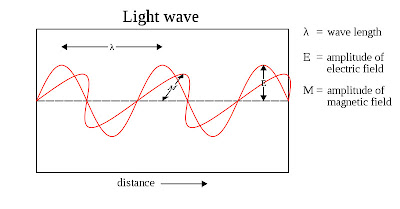Light is what enables us to see. Our eye sees things when light hit them and reflects back to our eyes carrying information. So what exactly is this light? Generally when we say light we are actually referring to visible light. Visible light is that portion of the Electro Magnetic Spectrum which is visible to the human eye (wavelengths in between 400 and 700 nm). Radio waves, micro waves, infrared waves, ultraviolet waves, x rays and gamma rays constitute the rest of the wavelengths of the Electro Magnetic Spectrum.
 |
| Light Wave - Image Courtesy - Wikipedia |
The primary properties of light are intensity, direction, frequency or wavelength and polarization. Light has both the properties of waves and particles and is emitted and received in tiny packets called photons. The study of light is called Optics.
Photography in simple terms is the process of capturing light. Although in order to be a successful photographer you need not research the physics of light; having an understanding of light, the basic properties of light, how it produces color, how it illuminates various subjects, how it behaves in different conditions and how to manipulate it will go a long way in improving your photographic skills, giving you complete mastery over the art that is photography.
Photography in simple terms is the process of capturing light. Although in order to be a successful photographer you need not research the physics of light; having an understanding of light, the basic properties of light, how it produces color, how it illuminates various subjects, how it behaves in different conditions and how to manipulate it will go a long way in improving your photographic skills, giving you complete mastery over the art that is photography.
The Four Fundamental Characteristics of Light
1. Light Always Travel in a Straight Line
Light always travels in a straight line; that is when travelling through a uniform medium, it keeps going in a straight line until it hits a subject, enters a different medium or simply exhausts its energy.
 |
| Photo by Deana |
2. Light Travels at Great Speed
Light travels extremely fast at the rate of 3,00,000 kilometers per second; fastest when travelling through vacuum, a bit slower when travelling through air and a bit more slower when travelling through other medium like glass.
 |
| Photo by Ken Douglas |
3. Light has Properties of both Waves and Particles
The phenomenon of having the properties of both waves and particles is called wave-particle duality. Light travelling in a straight line is like ripples crossing the surface of water. The variation in the wave lengths determines its color.
 |
| Photo by Rudolf Getel |
4. Light is a form of Energy
Light carries energy; it consists of very small packets of energy called photons. The number of photons determine the strength or brightness of light, the more the number of photos greater the strength / brightness and vice versa. It is the photons that cause chemical changes in films, bleach dyes and trigger electronic response in the sensor of digital cameras.
 |
| Photo by Aaron |
In the next article we will discuss about the relationship between Wavelengths and Colours.
Related Reading
- What Happens When Light Falls On a Surface
- Quality of Light
- Light And Colour
- White Light and Primary Colours
- Shadows